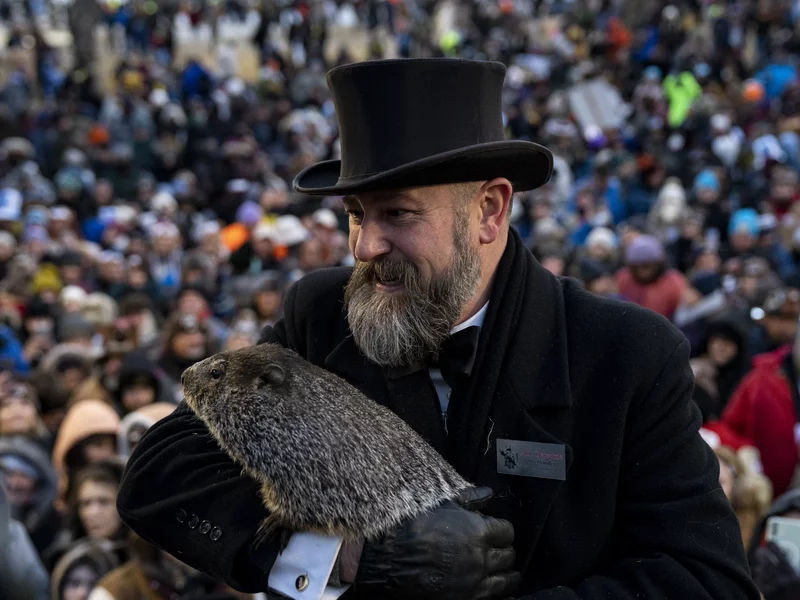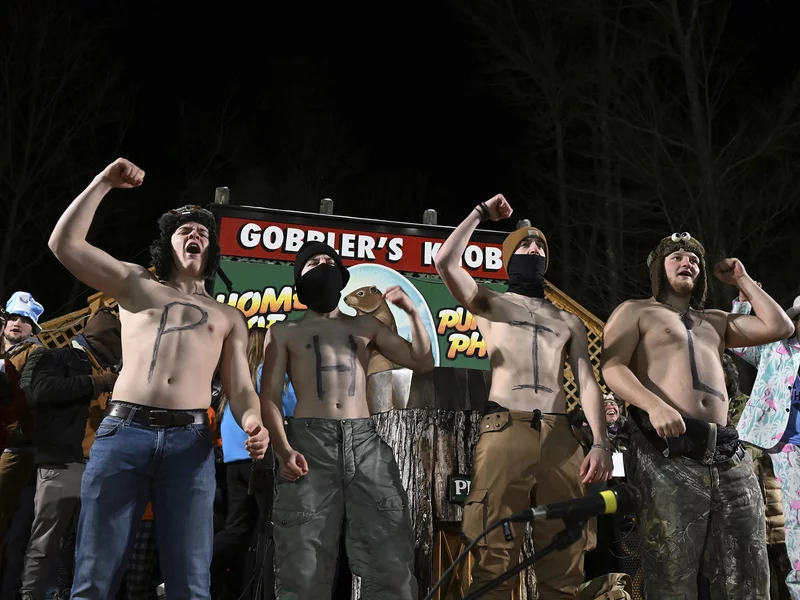How Groundhog Day came to the U.S. — and why we still celebrate it 137 years later
On Thursday morning, thousands of early risers either tuned in or bundled up to watch Punxsutawney Phil emerge from a tree stump and predict the weather.
The groundhog — arguably the most famous member of his species and the most recognizable of all the country's animal prognosticators — did what he has done for the last 137 years: search for a sign of spring in front of a group of top hat-wearing handlers and adoring fans at Gobbler's Knob in Pennsylvania.
Unfortunately, on this blustery winter morning, he didn't find it.
"I see a shadow on my stage, and so no matter how you measure, it's six more weeks of winter weather," a handler read off the scroll he said Phil had chosen.
Tradition says that North America will get six more weeks of winter if Phil sees his shadow and an early spring if he does not. Statistics say not so much: Phil's accuracy rate is about 40% over the last decade.
Plus, human meteorologists have far more advanced methods for predicting the weather now than they did when Phil first got the gig in 1887.
Why, then, do we continue looking to creatures for answers on Feb. 2, year after year after year? (One could say it's almost like the 1993 comedy "Groundhog Day" ... or even exactly like that.)
There's still a lot we can learn from Groundhog Day, both about our climate and our culture, several experts told NPR.
Daniel Blumstein is a professor of ecology and evolutionary biology at UCLA who studies marmots, the group of 15 species of large ground squirrels that includes groundhogs. His department always has a Groundhog Day party, even in perennially-sunny Los Angeles — but he says you don't have to be a "marmot enthusiast" (as he describes himself) to get something out of the day.
"I hope that people have some greater appreciation of marmots and nature, and I hope that people have a chuckle over the idea that it's the middle of the winter and we're hoping that a rodent will tell us what the future is," says Blumstein.
Groundhog Day has its roots in ancient midwinter ceremonies
How did the U.S. end up celebrating Groundhog Day in the first place?
It dates back to ancient traditions — first pagan, then Christian — marking the halfway point between the winter solstice and spring equinox, says Troy Harman, a history professor at Penn State University who also works as a ranger at Gettysburg National Military Park.
The Celtic tradition of Imbolc, which involves lighting candles at the start of February, goes as far back as the 10th century A.D.
The Christian church later expanded this idea into the festival of Candlemas, which commemorates the moment when the Virgin Mary went to the Temple in Jerusalem 40 days after Jesus' birth to be purified and present him to God as her firstborn.
On that feast day, clergy would bless and distribute all the candles needed for winter — and over time the focus of the day became increasingly about predicting how long winter would last. As one English folk song put it: "If Candlemas be fair and bright / Come, Winter, have another flight; If Candlemas brings clouds and rain / Go Winter, and come not again."
Germany went a step further by making animals — specifically hedgehogs — part of the proceedings. If a hedgehog saw its shadow, there would be a "second winter" or six more weeks of bad weather, according to German lore.
That was one of several traditions that German settlers in Pennsylvania brought to the U.S., Harman says, along with Christmas trees and the Easter bunny. And because hedgehogs aren't native to the U.S., they turned to groundhogs (which were plentiful in Pennsylvania) instead.
"And the first celebration that we know of was in the 1880s," Harman says. "But the idea of watching animals and whether they see their shadow out of hibernation had been going on before that, it just hadn't turned into a public festival until later in the 19th century."
The "Punxsutawney Groundhog Club" was founded in 1886 by a group of groundhog hunters, one of whom was the editor of the town's newspaper and quickly published a proclamation about its local weather prognosticating groundhog (though Phil didn't get his name until 1961). The first Gobbler's Knob ceremony took place the next year, and the rest is history.
The club says Groundhog Day is the same today as when it first started — if the old-timey garb and scrolls are any sign — just with far more participants. That's thanks in large part to the popularity of the eponymous movie and the ability to live-stream the festivities.
And there are more furry forecasters out there too. Many parts of the U.S. and Canada now have their own beloved animal prognosticators, with some of Phil's better-known contemporaries including New York's "Staten Island Chuck" (aka Charles G. Hogg) and Ontario's "Wiarton Willie."
"Any place that has a groundhog these days is trying to get some [cred] by it," Blumstein says.
It's not only groundhogs that are getting in on the fun. Take, for example: Pisgah Pete, a white squirrel in North Carolina, Connecticut's Scramble the Duck and a beaver at the Oregon Zoo named "Stumpton Fil."
There are things animals can teach us about the climate
There is some scientific basis for the Candlemas lore, according to Blumstein.
He says the thinking was that if there was a high-pressure system in early February, things likely weren't changing and it would probably continue to be cold, while a low-pressure system suggests the potential for better weather ahead. Plus, if it is sunny out, marmots are theoretically big enough to cast a shadow by standing up.
But that alone doesn't make them reliable forecasters.
"Whether or not there is a predictability of whether it's sunny on Groundhog Day and whether spring comes early or later, I don't know," Blumstein says, adding that Phil's predictions involve "him whispering into people who are wearing stovepipe hats and in front of a drunk crowd, so you can't really trust that."
Still, he says there's a lot humans can learn from groundhogs' behavior. He runs a long-term project that is about to begin its 62nd year of studying yellow-bellied marmots in Colorado, as a window into longevity and how flexible animals are in responding to a warming climate.
"Maybe it's a good thing for marmots in that you have a longer growing season, but then every day you're active, you also face some risk of predation," he explains. "And what we're finding is there's sort of an optimal period that you should be active. So there also could be evolutionary responses to this, and what we're really looking at is the evolutionary response to changes over time and the sort of within-generational plasticity, flexibility, if you will."
As part of that research, Blumstein spends time on skis, in the snow, waiting for the yellow-bellied marmots to come out from hibernation.
So he's able to confirm that while Groundhog Day is pegged to Candlemas, it also coincides with the time of year when groundhogs in the northeastern U.S. start to emerge. The males typically come out first and then begin looking for females with whom to mate.
"Groundhog Day is really a holiday about sex," he adds.
Blumstein says all animals, not just the prognosticators, deserve respect. While some people consider groundhogs a nuisance because they like to snack on garden produce, he thinks living with urban and suburban wildlife is a good thing as it brings people closer to nature.
"So I sort of see the ability to, if you're fortunate enough to have a groundhog living in your backyard, to sort of pay attention to it and enjoy it and learn from it and maybe give up some of your tomatoes or apples."
Technology improves, but people still look to Phil
Crowds as large as 30,000 have turned out to Punxsutawney for multi-day Groundhog Day festivities, which the state calls a significant tourism boost for the town of fewer than 6,000 people.
The ceremony itself — which returned to the stage last year after a COVID-19 hiatus — features dancers, music, speeches and visitors from around the world.
"That many nationalities being together all in one place to remember something from the medieval past and from a premodern period, and to bring in the music and to bring in the foods and the culture — it's a real uplifting event," Harman says.
He has a theory for why Groundhog Day became, and remains, so popular in the U.S.
"Throughout history, whenever there has been a real strong emphasis on science, its counterpart of intuition, instinct, emotion, imagination — the right side of our brain — pushes back a little bit," Harman says, explaining that Groundhog Day took off right around the time of the industrial revolution.
He says those massive societal and technological changes spurred a desire to return to what people imagined were simpler times, in the form of things like literary romanticism and gothic revival architecture.
Punxsutawney Phil's handlers, known as the "Inner Circle," continue to wear dark tuxedos, long tails and top hats even today, he points out. At the same time, technological advances have made us less in tune with the changing of the seasons: People once looked up to the stars and sun to determine the time of day or year; now they look down at their cell phone screens.
Holding onto culture is important, as is embracing new culture, Harman says. He thinks over time there will be "some happy ground" — and that may already be the case in Punxsutawney.
"I strongly suspect that the people that go to Gobbler's Knob are fully aware of the power of science, but at the same time want to hold on to traditions and a deeper vibe," he says. "There's the instincts and the intuition and the imagination that every human being has that has to come into balance with logic and reason."




